Old Man's Beard
The Old Man's Beard ( Tillandsia usneoides ), and sometimes called "Spanish Moss" is one of the easiest plants to grow. It does'nt require watering , fertilising or weeding, it just survives on air, and all it really needs is somewhere to hang...a support. This plants natural habitat is as an Epiphyte in trees.... it uses the trees only for support, and gets it's nutrients and water from whatever falls on it, or blows in the wind, such as regular rain, dust , bird droppings and anything else that comes its way. This plant is a member of the Bromeliad family, which are also Epiphytes. Old Man's beard is native to the Americas - the South -East USA, and down through Central America to Argentina, and it likes an atmosphere with humidity.
Plants which grow too long can break off in the wind, and fall on to another branch, and start growing there, or alternatively, the Tillandsia spreads by seeds which develop after the tiny green flowers are pollinated. The best spot for it is under trees, in a semi-shaded position, and it dislikes cold climates with frost, so temperate to warm climate with humidity suits best.
Use some imagination and you can create some interesting garden features when growing the Old Man's Beard and you are sure to impress your Grandfather ! I took these photos in various Sydney gardens.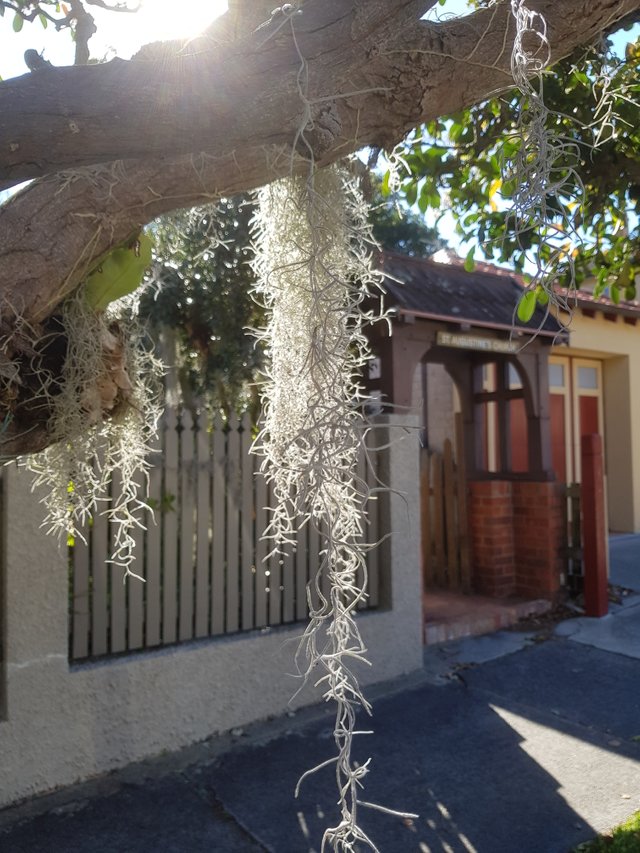
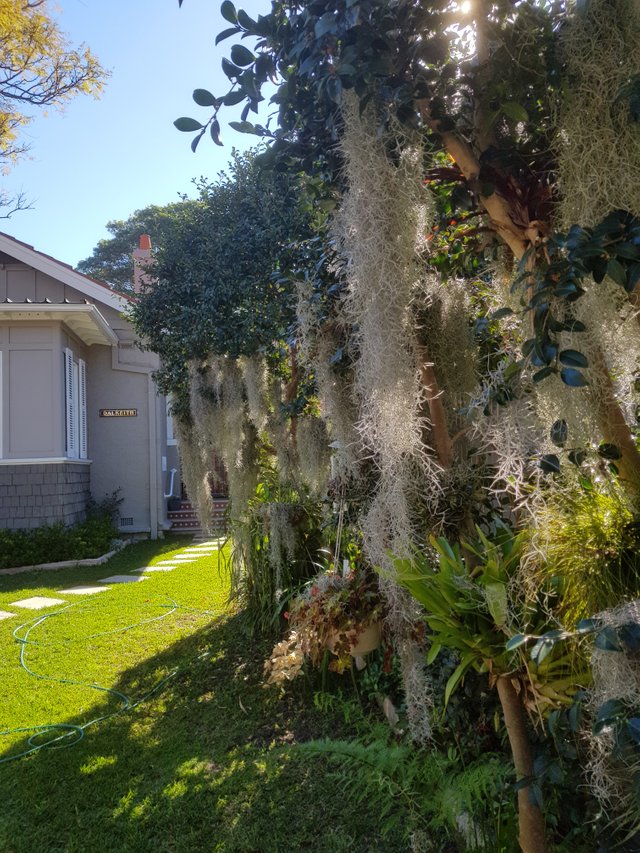
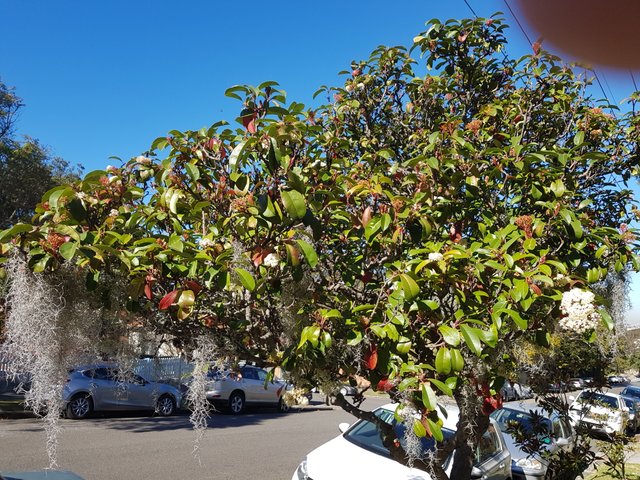
It’s that stuff that gently sways in the breeze as it drapes over the branches of an old oak tree in the South, right? But what really is Spanish moss? Is it actually Spanish? Is it actually a moss — or something else entirely? Today we’re going to take an in-depth look at the most commonly-grown air plant in the United States and find out all about its history, growth habits, and a few common uses for its foliage.
The name “Spanish moss” actually originated as “Spanish beard”. Native American tribal people called it “itla-okla”, which meant “tree hair”. Some French thought that it resembled a conquistador’s long beard and began calling it “Barbe Espagnol”, or Spanish beard. While the Spaniards retaliated by referring to it as “Cabello Frances”, or French Hair, it never caught on.
https://www.epicgardening.com/spanish-moss-tillandsia-usneoides/
Fav. comment Award ! Thanks for the excellent Pics.
Tillandsia usneoides (commonly called Spanish moss, although it is neither Spanish nor moss) is an atypical angiosperm, a primitive and xerophytic member of the Bromeliaceae. It is native to the coastal plain of the United States from Virginia to Texas and to tropical America as far south as Argentina and Chile. Its distribution may be correlated with major storm paths (Garth 1964). The blue-gray plant consists of a slender stem, up to 25 feet long, with alternating leaves growing chain-like to produce “festoons” (Billings 1904). The leaves are needle-shaped and covered with silver-gray scales. The inconspicuous fragrant flowers, which appear from April to June, are blue or pale green and have three petals. Spanish moss is dependent upon a host species or object upon which to grow. It is typically found on the branches of sparsely foliated or dead deciduous trees in high-humidity environments with soils rich in calcium carbonate (Garth 1964).
Spanish moss can grow from seeds but is typically spread by windblown fragments or from fragments incorporated in birds’ nests. This epiphyte has no roots; it captures all its water and nutrients from rain and dust in the atmosphere. Its vascular system is degenerate: Spanish moss has no functional xylem or phloem, water is absorbed by scales over the entire surface of the plant and every cell of the plant either photosynthesizes on its own or is proximal to a cell that shares resources (Billings 1904). It fixes carbon by Crassulacean acid metabolism (CAM), an adaptation to arid conditions in which carbon dioxide enters the stomata at night to reduce loss of water in its cells.
Source: http://eol.org/pages/355461/details
Fav. comment Award ! Well done for selecting great pics.
Spanish moss (Tillandsia usneoides) is an epiphytic flowering plant that often grows upon larger trees in tropical and subtropical climates, native to much of Mexico, Bermuda, the Bahamas, Central America, South America, the southern United States, French Polynesia and the West Indies and is also naturalized in Queensland (Australia). It is known as "grandpas beard" in French Polynesia.[2] In the United States from where it is most known, it is commonly found on the southern live oak (Quercus virginiana) and bald-cypress (Taxodium distichum) in the lowlands, swamps, and savannas of the southeastern United States from southeast Virginia south to Florida and west to Texas and southern Arkansas.
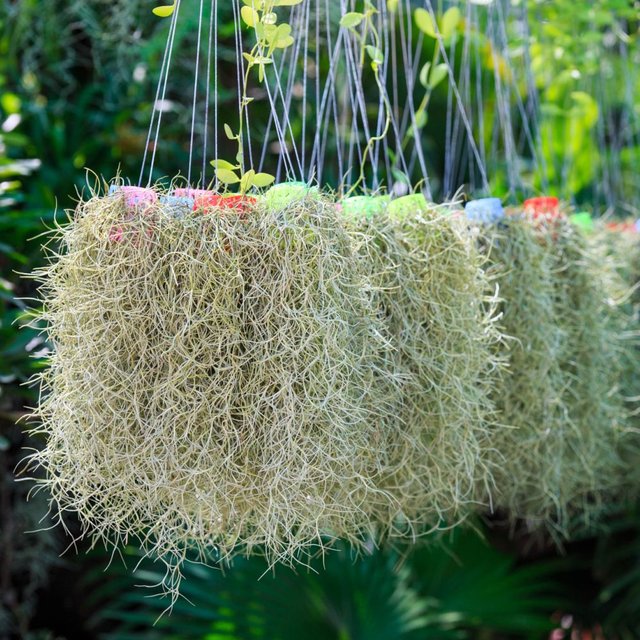

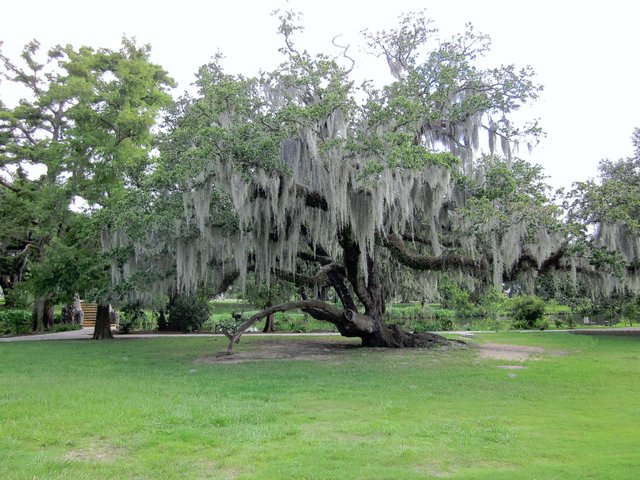
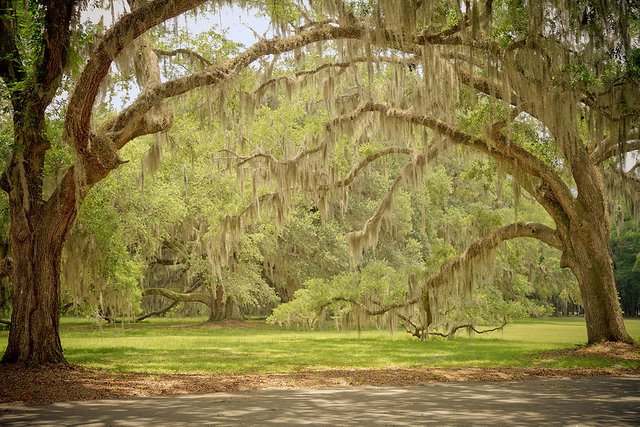
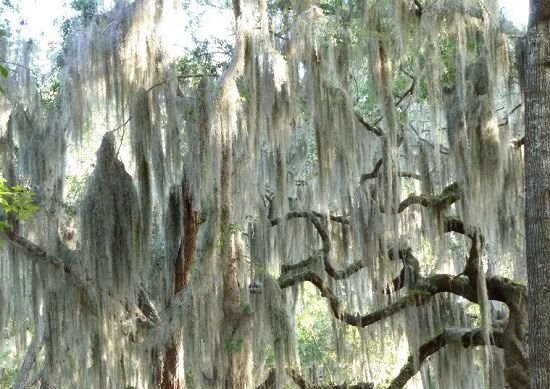
This plant's specific name usneoides means "resembling Usnea", and it indeed superficially resembles its namesake Usnea, also known as beard lichen, but in fact Spanish moss is neither a moss nor a lichen. Instead, it is a flowering plant (angiosperm) in the family Bromeliaceae (the bromeliads) which grows hanging from tree branches in full sun through partial shade. Formerly this plant has been placed in the genera Anoplophytum.
Caraguata, and Renealmia.[5] The northern limit of its natural range is Northampton County,[6] Virginia, with colonial-era reports in southern Maryland[7][8][9][10] where no populations are now known to be extant.[10] The primary range is in the southeastern United States (including Puerto Rico), through Argentina, growing where the climate is warm enough and has a relatively high average humidity. It has been introduced to similar locations around the world, including Hawaii and Australia.
Source
Silly Sausage Award ! Very nice selection of Pics.
YOU ARE HERE: HOME / LANDSCAPING / TREES & SHRUBS / HOW TO GROW SPANISH MOSS
How to Grow Spanish Moss
1 COMMENT
spanish moss growing
If you live in or have ever visited parts of the Deep South, you will likely be familiar with the gray, hairlike strands dangling from many of the trees. This eerie plant is Spanish moss. Known as “itla-okla,” or “tree hair” by indigenous Americans, Spanish moss grows on other trees to thrive. Despite its need for a host, Spanish moss is not a parasite—it is an epiphyte. The plant does not send roots into the host tree and it does not draw nutrients from the tree. Learn more about air plants.
Despite its name, Spanish moss is neither Spanish nor moss; Spanish moss is native to Mexico, Central America, the Caribbean, and parts of the southern United States from Texas to Virginia. It is considered a flowering plant, a member of the same family as pineapples and succulents. The plant is made up of slim stems with scaled leaves that grow to create a hanging structure. Although the plant produces brown, green, or yellow flowers, they are difficult to spot.
https://www.gardeningchannel.com/how-to-grow-spanish-moss/
@ctrl-alt-nwo,
This plant is in my country! Like you said, we are not watering it regularly! I think it use air to get water! It's beautiful and personally I like to see this plant in every garden! Like you said, semi shaded places are the well suited area for this plant to grow! Nice photography and description about this plant!
Cheers~
Shared on twitter promoting great content on #Steemit.
It's always a pleasure to share your photographs on twitter for my followers to see.
Have a great day.
Stephen
#Promo-Steem #steemtalent #JoinSteemit #Steemit
Old Man's Beard. #STEEM #steemtalent #JoinSteemit #Steemit
#garden #gardening #gardensworld #plant #life #blog #blogger #australia #photography #photographer
https://twitter.com/StephenPKendal/status/1057579603433320448
Lovely plant my friend and Tillandsia usneoides is a flowering plant that grows upon larger trees, commonly the Southern Live Oak (Quercus virginiana) or Bald Cypress (Taxodium distichum) in the south-eastern United States. It grows hanging from tree branches in full sun or partial shade. Its natural range is from Virginia Beach, Virginia in the south-eastern United States to Argentina, growing wherever the climate is warm enough and has a relatively high average humidity. It has been introduced to similar locations around the world, including Hawaii and Australia.
While it rarely kills the trees, it lowers their growth rate by reducing the amount of light to a tree’s own leaves. It also increases wind resistance, which can be fatal to the host tree in a hurricane. In the southern United States, the plant seems to show a preference of growth on Southern Live Oak (Quercus virginiana) or Bald Cypress (Taxodium distichum) because of these trees’ high rates of foliar mineral leaching (calcium, magnesium, potassium, and phosphorus) providing an abundant supply of nutrients to the plant, but it can also colonize other tree species such as Sweetgum (Liquidambar styraciflua), crepe-myrtles (Lagerstroemia spp.), other oaks and even pines.
Tillandsia usneoides is an epiphyte which absorbs nutrients (especially calcium) and water from the air and rainfall.
The plant consists of a slender stem bearing alternate thin, curved or curly, heavily scaled leaves 2–6cm (0.79–2.4 inch) long and 1mm (0.039 inch) broad, that grow vegetatively in chain-like fashion (pendant) to form hanging structures up to 6m (240 inch) in length. The tread-like stems covered with grey scales are in reality, minute, scaly leaves. The plant has no aerial roots and its flowers are tiny and inconspicuous. The tiny, pale green flowers that appears in the leaf axil of wild Tillandsia usneoides, rarely bloom on plants grown indoors. The flowers, with a musk fragrance, appear in the warmer months.
Thank you @ctrl-alt-nwo
A source of information: http://www.plantsrescue.com/tillandsia-usneoides/
That one is really beautiful!!
in my part, i like more the vegetables / fruits plants than the ornamental ones
Amazing plant @ctrl-alt-nwo! Spanish moss is neither from Spain nor a moss; it is an epiphytic member of the pineapple family from the Americas. Epiphytes are plants growing on other plants from which they derive no nutrients. Across its native range, from southeastern North America through Central and South America as far south as Argentina and Chile, it is a common sight draped over trees in high humidity areas. There is even evidence that the distribution of Tillandsia usneoides is correlated with the damage created by major storms. Carolus Linnaeus' use of the specific name, usneoides (Usnea-like), refers to the plant's superficial morphological and ecological similarity to the lichen genus Usnea, which is a symbiotic relationship between a blue-green alga and a fungus.
Tillandsia usneoides is rootless, consisting of narrow, alternate leaves arranged along a slender, wiry, silvery blue-green stem. Tillandsia usneoides lacks an extensive vascular system but is covered in tiny, water-absorbing scales; all the plant's water and nutrient needs are derived from rain, dust and detritus. Since Tillandsia usneoides gets all of its nutrients from the atmosphere it has been extensively investigated as a monitor for heavy metal pollution in urban areas.
In addition to morphological adaptations, Tillandsia usneoides shows a specific biochemical adaptation to growth in arid conditions, where water resources are likely to be limited; atmospheric carbon dioxide is fixed by a modification of photosynthesis called Crassulacean Acid Metabolism (CAM). In CAM photosynthesis, stomata (pores in plant surfaces) open at night; carbon dioxide enters the plant, where it is converted to organic acids. During the day, when the stomata are closed, the organic acids are transformed back to carbon dioxide and the normal machinery of photosynthesis converts carbon dioxide and water into sugars.
The biology of Tillandsia usneoides means it is a good disperser. Vegetative propagation occurs by stem fragments being carried by the wind or by birds; new plants readily growing from pieces trapped on trees or telegraph wires. The small, insect-pollinated flowers of Tillandsia usneoides have blue-green petals, but are frequently overlooked. When ripe fruit capsules open, small, flat, hairy, wind-dispersed seeds are released.
Human uses of this curious plant are limited. Stem fibres have been used by Native American cultures for weaving and rope-making, whilst whole plants, mixed with clay, have been used as daub, as medicine and even as animal fodder. Today, Tillandsia usneoides is most familiar as packing material or as a house plant.
A source: https://herbaria.plants.ox.ac.uk/bol/plants400/profiles/ST/Tillandsia
Spanish moss (Tillandsia usneoides) is an epiphytic flowering plant that often grows upon larger trees in tropical and subtropical climates, native to much of Mexico, Bermuda, the Bahamas, Central America, South America, the southern United States, French Polynesia and the West Indies and is also naturalized in Queensland (Australia). It is known as "grandpas beard" in French Polynesia. In the United States from where it is most known, it is commonly found on the southern live oak (Quercus virginiana) and bald-cypress (Taxodium distichum) in the lowlands, swamps, and savannas of the southeastern United States from southeast Virginia south to Florida and west to Texas and southern Arkansas.

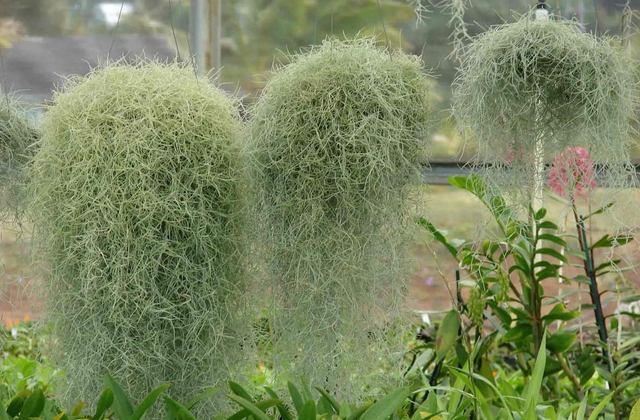.png)
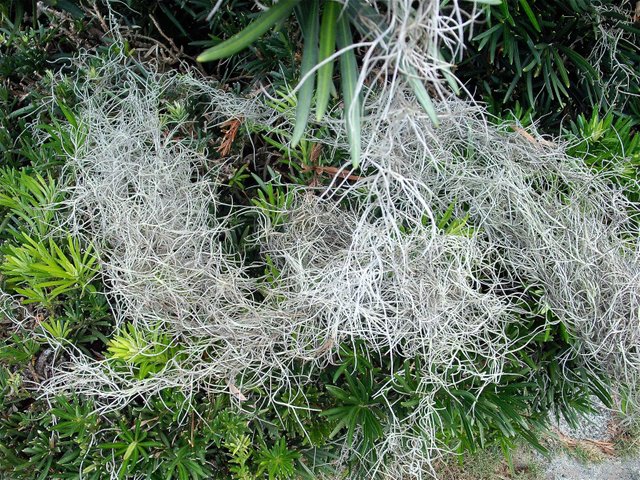
Source
Source
Source
This plant's specific name usneoides means "resembling Usnea", and it indeed superficially resembles its namesake Usnea, also known as beard lichen, but in fact Spanish moss is neither a moss nor a lichen. Instead, it is a flowering plant (angiosperm) in the family Bromeliaceae (the bromeliads) which grows hanging from tree branches in full sun through partial shade. Formerly this plant has been placed in the genera Anoplophytum, Caraguata, and Renealmia. The northern limit of its natural range is Northampton County, Virginia, with colonial-era reports in southern Maryland where no populations are now known to be extant. The primary range is in the southeastern United States (including Puerto Rico), through Argentina, growing where the climate is warm enough and has a relatively high average humidity. It has been introduced to similar locations around the world, including Hawaii and Australia.
Source
close your name of my list @msena
Thank you, I'm glad that you understand.
Quite a nice plant to give our trees some highlights @ctrl-alt-nwo and people sometimes wonder what are those beard-looking thing that hangs like beard or grey hair.